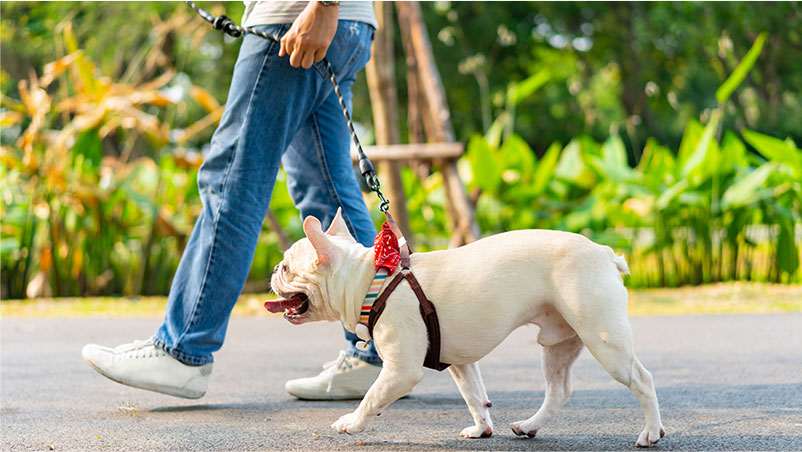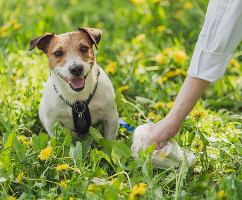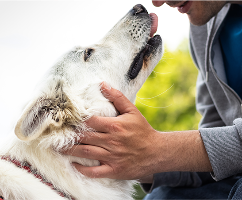A sunny walk in the park with your wet-nosed companion is one of the sweetest moments in a pet-parent relationship.
Leash training is an essential step to being able to take fun-filled walks! And, if you live in the city, leash
training is non-negotiable.
So, how do you leash train a dog? We put together a complete guide to leash training, including how to train a
reactive dog and also puppies.
How To Leash Train A Dog

Being comfortable on a leash opens up possibilities for you and your pup! Training your dog to walk on a leash requires few supplies and a lot of repetition. Gather a harness, leash, training treats and all of your patience. Patience and consistency are key when leash training. Each dog will learn at their own pace, but every pet is capable!
Step 1: Introduce The Harness & Leash
The first step in leash training is to familiarize your pup with the harness and leash. Let them sniff the items
first. Then, put the harness and leash on.
Play with and reward your fur baby with their favorite training treat while they’re wearing the leash. It’s
important to use healthy, low-calorie treats while training. We recommend freeze-dried
treats that are highly
digestible. Repeat this “playtime” a few times so they learn that leash time is fun!
Step 2: Teach A “Come” Cue
Before you and your pup can actually go on a walk together, they need to learn a “come” cue that signals a treat is
on its way. Practice your cue with your pup on the leash.
This cue will come in handy when distractions approach, or if your fur baby is pulling on the leash. If you walk
near roads, it’s also important for your dog’s safety!
Pet parent tip: Make sure you have your pup’s favorite, healthy treats for training on hand! If they don’t
absolutely love their reward, you’ll have a harder time getting them to come when distractions show up. You’ll also
be giving your fur baby a lot of these treats, so we recommend finding healthy, all-natural options.

|
pawTreats
|

|
pawTreats
|

|
pawTreats
|

|
pawTreats
|
Step 3: Practice Leash Walking Inside
Next up: Try out leash walking inside or in a familiar, low-distraction environment. Practice your “come” cue and
encourage your dog to walk by your side, rather than in front of you or behind you. It’s helpful to use short,
non-retractable leashes.
Praise and reward them often! Reward them when they walk near you, as well as when they stop pulling on the leash.
Step 4: Take Them Outside!
Level up your environment gradually. If you’ve only been inside your apartment, your fur baby probably isn’t ready
for rush hour traffic. Find remote outdoor areas and less busy times until you’re both comfortable and confident.
If you see a distraction approaching, use your “come” cue, move a few steps away, and reward them for obeying.
Do’s And Don’ts Of Leash Training For Reactive Dogs And Puppies

Each fur baby is unique and brings different obstacles (as well as different strengths) to leash training. Training
puppies and leash reactive dogs are some of the trickier types of fur babies to train.
If you’ve got a pup who likes to lunge or a tiny, new baby at home, here are a few expert tips.
For Puppies:
✓ Do start immediately!
Usually, you can’t take a pup home until they're about 4 or 5 months old. This is the perfect age to start leash
training. If you have a fur baby younger than 4 months, use a harness with a back attachment point.
✓ Do keep training sessions short.
Puppies have short attention spans. End sessions while they’re still eager to do more, rather than waiting until
they’re exhausted.
✘ Don’t yank or drag your pup behind you.
You want to find a comfortable pace for both of you. Encourage your puppy to walk by your side with a loose leash
tension.
✓ Do stand still, and don’t move if they pull.
Become a “tree,” standing still with your leash held at your belly. Say “no pull” or “oops.” Then, use your “come”
cue and don’t move until they do.
For Dogs That Lunge:
✘ Don’t pull or yank!
This is dangerous for both of you and largely ineffective in teaching good behavior.
✓ Do redirect with a treat and walk away from the target.
If your pup does lunge, use your “come” cue and get their attention with a treat. If you see a potential target
approaching, you can put a treat in your hand and hold it near their nose while the distraction passes.
✘ Don’t approach other dogs and humans head on.
In the doggy world, approaching one another head on indicates aggression, meaning your pup might feel threatened and
react. Instead, walk to the side of oncoming dogs.
✓ Do maximize distance between distractions.
If you see a potential distraction, walk around! You can even take a quick break and distract your pup entirely if
needed.
For Dogs That Bark:

✘ Don’t punish them for barking.
Barking is a warning sign; discouraging this could result in surprise biting or other attacks. Instead, follow the
lunging protocol and redirect with a treat.
✓ Do make sure they get plenty of physical and mental stimulation.
Sometimes barking is just pent-up energy! If your pup has plenty of stimulation throughout the day, they’re likely
to have less to say on their walk.
✓ Do reward dogs with treats as other dogs/humans approach.
Your dog is likely barking because they feel threatened. When you see another dog approaching, use your “come” cue
and reward your pup as the distraction passes. This helps your dog realize other dogs are friends!
For Dogs That Bite The Leash:
✘ Don’t pull the leash away.
This makes it a game of tug-of-war for them. Instead, loosen the tension and push the leash closer to your pup’s
mouth.
! Maybe walk with two leashes.
For pups that can’t let the game go, try using two leashes. When your dog bites one, drop it and use the other.
Switch back and forth until they lose interest.
Joyful walks in the park are in your near future! Patience and a little training will mean you and your fur baby
will be strolling the city together in no time.
You Might Also Like
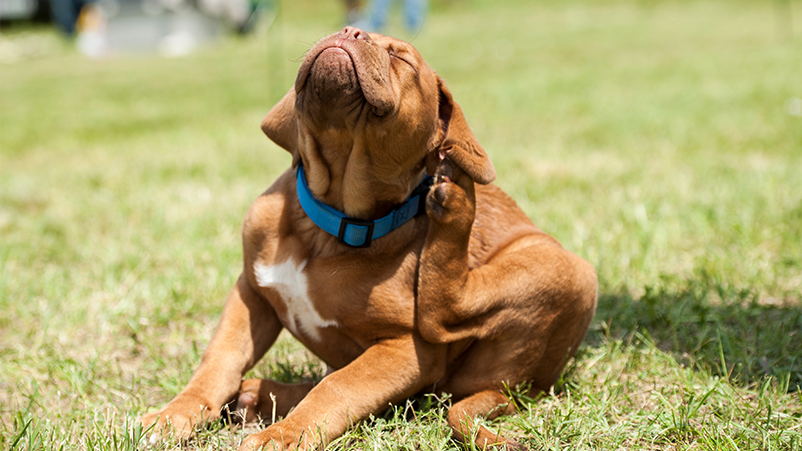
Say Goodbye To Fleas: A 3-Step Solution For A Healthy Pet And A Clean Home Read More |
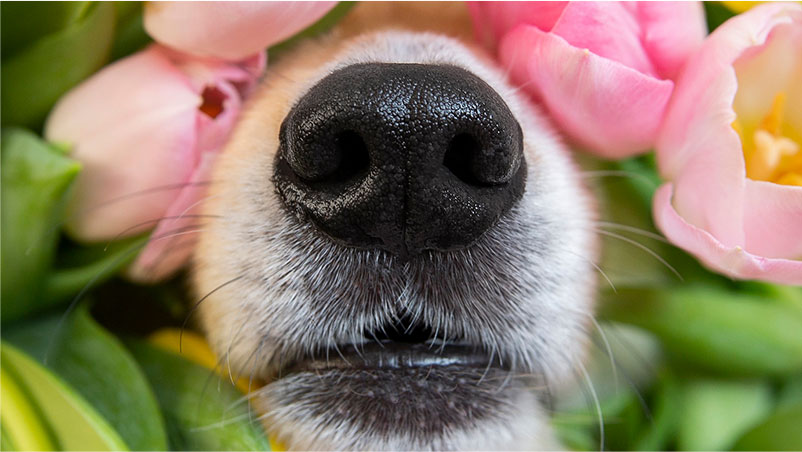
Symptoms Of Seasonal Allergies In Pets And How To Treat Them Read More |

One-Month Pet Wellness Plan to Elevate Their Health Read More |

Say Goodbye To Fleas: A 3-Step Solution For A Healthy Pet And A Clean Home
Symptoms Of Seasonal Allergies In Pets And How To Treat Them
One-Month Pet Wellness Plan to Elevate Their Health

